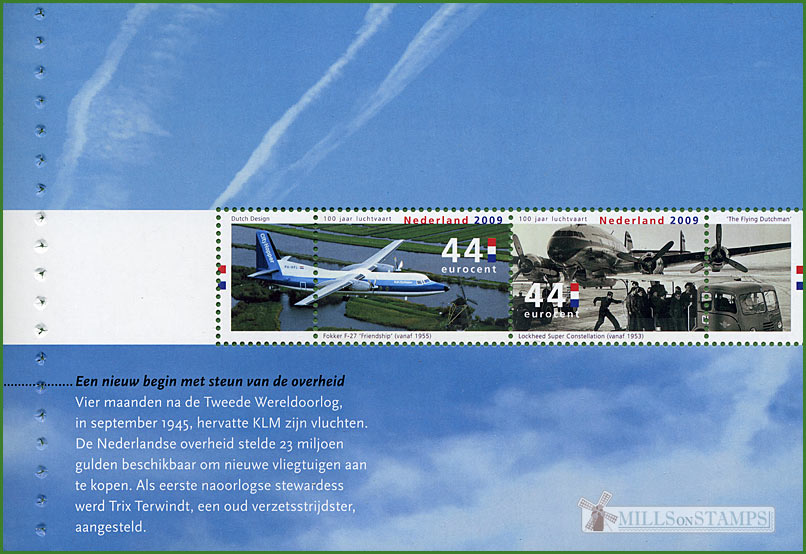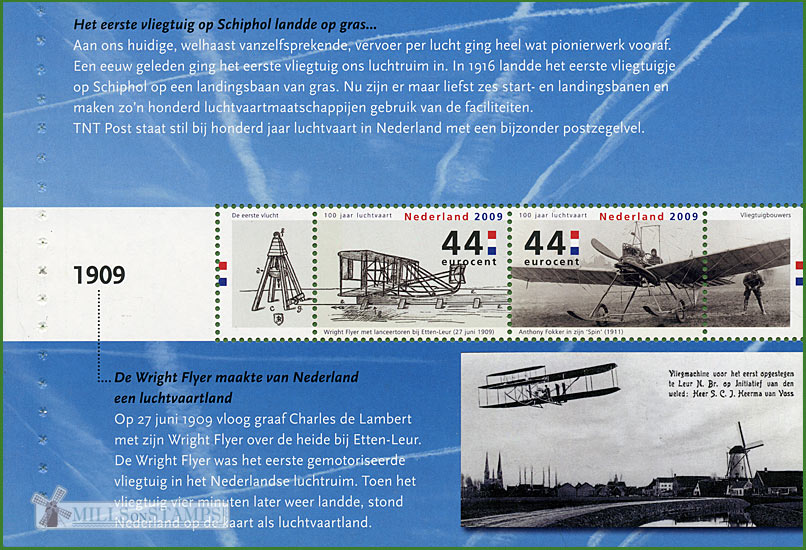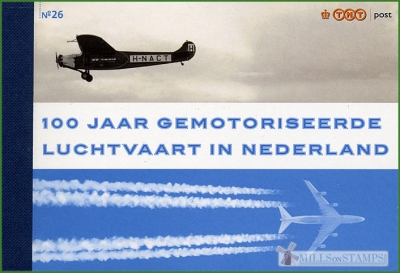-
100 years of motor aviation in Holland
Netherlands 2009.10.07
In issue: Stamp(s): 10 Sheet(s): 1 Booklet(s): 1
Issued in: mini sheets of 10 (2*5) stamps as one set and in prestige-booklets
-
Perforation type: 13 ¼x13 ¾
Subject:
44 cents. Aircraft Fokker F-27 * flying over the Dutch fields and polders**
Size (of sheet, booklet) mm: 108x150
Topics: Windmills
-
Perforation type: 13 ¼x13 ¾
Subject:
The prestige-booklet contains 5 souvenir sheets and 12 pages with the description of the materials used for release.
The pair various stamps is included in each souvenir sheets and on two of them in a plot there including a windmills.Additional:


*The Fokker F27 "Friendship" is a turboprop airliner designed and built by the Dutch aircraft manufacturer Fokker.
Design of the Fokker F27 started in the 1950s as a replacement to the successful DC-3 airliner. The manufacturer evaluated a number of different configurations before finally deciding on a high-wing twin Rolls-Royce Dart engine layout with a pressurised cabin for 28 passengers.
The first prototype, registered PH-NIV, first flew on November 24, 1955. The second prototype and initial production machines were 0.9 m (3 ft) longer, addressing the first aircraft's slightly tail-heavy handling and also providing space for four more passengers, bringing the total to 32. These aircraft also used the more powerful Dart Mk 528 engine.*A polder is a low-lying tract of land enclosed by embankments known as dikes, that forms an artificial hydrological entity, meaning it has no connection with outside water other than through manually-operated devices.
The Netherlands is frequently associated with polders. This is illustrated by the English saying: God created the world, but the Dutch created Holland.
The Dutch have a long history of reclamation of marshes and fenland, resulting in some 3,000 polders [1] nationwide. About half of all polder surface within northwest Europe is located within the Netherlands. The first embankments in Europe were constructed in Roman times. The first polders were constructed in the 11th century. Due to flooding disasters water boards called waterschap (below sealevel) or hoogheemraadschap (above sea level) were set up to maintain the integrity of the water defenses around polders, maintain the waterways inside a polder and control the various water levels inside and outside the polder. Water bodies hold separate elections, levy taxes and function independently from other government bodies. Their function is basically unchanged even currently. As such, they are the oldest democratic institution in the country. The necessary co-operation between all ranks in maintaining polder integrity also gave its name to the Dutch version of third way politics - the Polder Model.
The 1953 flood disaster prompted a new approach to the design of dikes and other water-retaining structures, based on an acceptable probability of overflowing. Risk is defined as the product of probability and consequences. The damage in lives, property and rebuilding costs is offset against the cost of water defenses. From these calculations follow an acceptable flood risk from the sea at 1 in 4,000–10,000 years, while it is 1 in 100–2,500 years for a river flood. The established policy forces the Dutch government to improve flood defenses as new data on threat levels becomes available. For comparison, the risk of the (repaired) New Orleans dike system in the future collapsing due to sea flooding is estimated at 1 in 100 years[2] (i.e. flooding risks in New Orleans remain 100 times higher compared to Rotterdam which is set at 1/10,000)******
This information was been taken from Wikipedia
Size (of sheet, booklet) mm: 149x102
Topics: Mills within the landscapes Windmills


2009-sheet-logo.jpg)
2009-sheet-frgm-logo.jpg)
